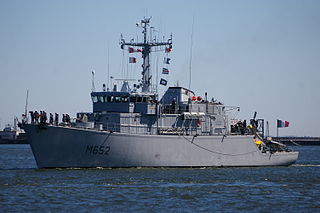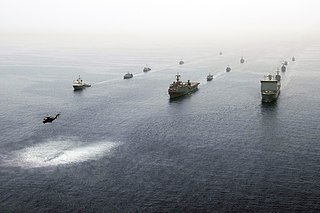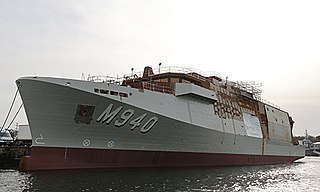
A minehunter is a naval vessel that seeks, detects, and destroys individual naval mines. Minesweepers, on the other hand, clear mined areas as a whole, without prior detection of mines. A vessel that combines both of these roles is known as a mine countermeasures vessel (MCMV).

Standing NATO Mine Countermeasures Group 1 (SNMCMG1) is a North Atlantic Treaty Organisation (NATO) standing mine countermeasures immediate reaction force. Its role is to provide NATO with an immediate operational response capability.

The Belgian Navy, officially the Belgian Naval Component of the Belgian Armed Forces, is the naval service of Belgium.

The Tripartite class is a class of minehunters developed from an agreement between the navies of Belgium, France and the Netherlands. A total of 35 ships were constructed for the three navies. The class was constructed in the 1980s–1990s in all three countries, using a mix of minehunting, electrical and propulsion systems from the three member nations. In France, where they are known as the Éridan class they are primarily used as minehunters, but have been used for minesweeping and ammunition transport in Belgium and the Netherlands, where the Tripartites are known as the Alkmaar class.

Aster is a Tripartite-class minehunter of the Belgian Naval Component, launched on 16 December 1985 at the Mercantile-Belyard shipyard in Rupelmonde and christened by Queen Paola of Belgium. The patronage of Aster was accepted by the city of Blankenberge. Aster was the first of the Belgian Tripartite-class minehunters.

Bellis (M916) is a Tripartite-class minehunter of the Belgian Naval Component, launched on 14 February 1986 at the Mercantile-Belyard shipyard in Rupelmonde and christened by Ellen Goffinet-Rosman, the wife of the then Mayor of Arlon, on 18 September 1986. The patronage of Bellis was accepted by the city of Arlon. It was the second of the Belgian Tripartite-class minehunters.

Crocus (M917) is a Tripartite-class minehunter of the Belgian Naval Component, launched on 3 September 1986 at the Mercantile-Belyard shipyard in Rupelmonde and completed on 5 February 1987. The patronage of Crocus was accepted by the city of Genk. It was the third of the Belgian Tripartite-class minehunters.
Lobelia (M921) is a Tripartite-class minehunter of the Belgian Naval Component, launched on 3 February 1988 at the Mercantile-Belyard shipyard in Rupelmonde and christened by Anne Van De Kerckhof, the wife of the then Mayor of Diest, on 25 February 1989. The patronage of Lobelia was accepted by the city of Diest. It was the seventh of the Belgian Tripartite-class minehunters. The Belgian Naval Component announced on its website on 5 November 2007 that Mrs. Van De Kerckhof, the godmother of Lobelia, had died on 27 October. A delegation of the crew of Lobelia attended her funeral.

Narcis (M923) is a Tripartite-class minehunter of the Belgian Naval Component, launched in 1990, at the Mercantile-Belyard shipyard in Rupelmonde and christened by Mrs. Lafosse-De Backer, the wife of the then Mayor of Mons, on 14 March 1991. The patronage of Narcis was accepted by the city of Mons. It was the ninth of the Belgian Tripartite-class minehunters. The Belgian government chose to deploy the ship as part of its involvement with enforcing the Libyan no-fly zone.
Primula is a genus of 400–500 species of low-growing herbs in the family Primulaceae.
Tsibar is a Tripartite-class minehunter of the Bulgarian Navy. The ship was formerly Myosotis (M922) of the Belgian Naval Component. Myosotis' keel was laid on 6 July 1987 at Ostend yard of Beliard-Murdoch. She was launched on 4 August 1988 and completed on 14 December 1989. Myosotis was stricken from the Belgian Naval Component in 2004 and sold to Bulgaria.

PNS Munsif (M166) is the lead ship of the Munsif-class minehunter currently in service with the Pakistan Navy.

Imanta (M-04) is the lead ship of the Tripartite class of minehunters for the Latvian Naval Forces. The vessel was formerly HNLMS Harlingen (M854), a Tripartite-class minehunter of the Royal Netherlands Navy built in 1984. Alkmaar and Imanta are, respectively, the Dutch and Latvian navies' names of the Tripartite class of minehunters, developed jointly by France, Belgium, and the Netherlands.

The Double Eagle is a remotely operated vehicle (ROV) built by the Swedish defence company Saab Underwater Systems AB and used for the disposal of naval mines.
Bellis is a genus of flowering plants in the family Asteraceae.
This article represents the structure of the Belgian Armed Forces as of May 2020:

The Netherlands and Belgium are doing a joint procurement for the replacements of the Tripartite-class/Alkmaar-class minehunters. Both countries want to procure six new mine countermeasure (MCM) vessels, which makes for a total of 12 MCM ships. The new MCM ships will include a range of unmanned systems including unmanned surface, aerial and underwater vehicles alongside towed sonars and mine identification and neutralization ROVs.

HNLMS Vlissingen (M840) is the second ship in the City / Vlissingen-class of mine countermeasures vessels, and first to be built for the Royal Netherlands Navy.

Oostende (M940) is the first ship in the City-class mine countermeasures vessels. She is being constructed in France for the Belgian Navy.














